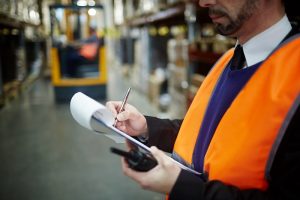Operating aerial lifts (or boom lifts) can subject employees to several occupational safety risks. So, employers need to take all necessary precautions when requiring an employee to do so.
It’s also important to understand what the Occupational Health and Safety Administration (OSHA) expects when operating these lifts to stay safe on the job site and avoid being subject to non-compliance consequences.
OSHA stipulates some crucial compliance requirements that’ll you need to consider when having your employees operate aerial lifts.
In this guide, we’ll break down all the OSHA requirements you need to be aware of when operating an aerial boom lift.
What Are Aerial Lifts?
The OSHA regulations you’re required to follow depend on what category lift you operate. Aerial lift regulations are specific to the nature and functionality of the lift.
According to OSHA, an aerial lift (also called Mobile Elevated Work Platform (MEWP)) is any vehicle-mounted device used to elevate employees to complete a job task. These machines include:
- extendable aerial platforms;
- jointed lift platforms (scissor lifts);
- vertical towers; and
- aerial ladders.


While aerial lifts provide greater mobility and flexibility to complete elevated job tasks, the elevated functionality creates an increased safety risk for severe injuries and death due to the lack of observation of OSHA boom lift safety requirements.
Aerial Lift Safety Hazards
For employers to understand the aerial lift safety process, they need to understand what hazards exist when operating a boom lift.
By identifying possible risks, they can ensure that all measures are taken to mitigate accidents while operating aerial lifts. This is not an exhaustive list, but the safety process should take the following potential hazards into account:
- falling from the elevated boom lift platform;
- vehicle tip-overs;
- collapsing structures;
- objects falling from lifts and injuring staff on the ground;
- ejections of personnel from the boom lift platform;
- electrocutions; and
- contact with overhead objects.
OSHA Regulations for Aerial Lifts
To help mitigate these hazardous events, OSHA provides several safety requirements centred on MEWP (Mobile Elevated Work Platform) lift training and fall protection.
MEWP Training: Aerial Lifts
The first and most obvious requirement is that only trained and authorized personnel are allowed to operate a boom lift.
Employees must be sufficiently trained on:
- how to correctly operate the lift – theoretical training (knowing about load capacity limits, for example) and practical training (demonstrations on operating boom lift);
- when to perform inspections (pre-operation inspections, for example);
- how to conduct inspections (including vehicle inspections and workplace inspections);
- the potential risks;
- safety rules;
- what safety harness to use to avoid injuries;
- procedures on how to deal with and manage those risks; and
- recognizing unsafe conditions to operate the boom lift.

Training shouldn’t be a one-off affair, especially in situations where there has been an accident or where a workplace hazard has been identified. Employees should also be retrained if a new boom lift is brought into the workplace or where the current aerial lift is being operated incorrectly.
Fall Protection: What is a Fall Restraint and Personal Fall Arrest System?
There are two types of OSHA fall protection requirements for aerial boom lifts:
- Fall restraint: a fall restraint system, which includes a restraining body, prevents the employees operating the aerial lift from being exposed to any fall. The employer must provide the body belt, and it must have a lanyard that connects to the boom platform or bucket.
- Fall arrest: with a fall arrest system, which prohibits body belts and requires a full-body safety harness, the lanyard that connects the body harness to the boom platform and bucket limits the fall distance and arrests force on the employee. Generally, a fall arresting lanyard has a shock-absorbing section and is self-retracting.

How Can Insure Compliance Help Aerial Lift Operators?
Aerial lift training is a crucial step in satisfying OSHA requirements and reducing the risk of safety issues.
Only authorized persons can operate aerial lifts. Before authorizing any of your employees and personnel to operate a boom lift, you must require aerial lift operators to obtain the proper training and receive the necessary certifications to mitigate injuries and fatalities.
With proper OSHA-compliant aerial lift certification and fall protection, you can create a safe and more productive working environment.

At Insure Compliance, we focus on solving the safety gaps you have in your business to help get you compliant with OSHA’s regulations and to prevent aerial lift injuries and fatalities.
Our training focuses on:
- pre-commencement inspections to help personnel inspect and verify that the equipment and all its components are in safe operating condition and that all potential hazards are eliminated from the work zone before operation commences;
- what to do when operating an aerial lift, including fall protection systems, operation, loading capacities, overhead protection, and stability in the work zone;
- practical training to help you safely operate the lifts; and
- how to prepare for an OSHA inspection in the event that an injury or fatality occurs.
With our Safety Gap Model, we apply gap analysis to specifically solving:
- potential job hazards;
- aerial lift policies;
- aerial lift training;
- work zone and equipment inspections; and
- workplace accountability.
Key Takeaways
Before authorizing employees to operate aerial lifts, task-specific training on the equipment and fall protection is a must.
In addition to this, OSHA recommends that you:
- utilize a safety harness or body belts when operating an aerial lift;
- follow all manufacturer’s instructions and recommendations in regards to the operation of your aerial lifts; and
- ensure there are no hazards in the surrounding work zone.
When it comes to safety on the job site, knowledge is power.
At Insure Compliance, we work with companies to create a healthy and safe working environment for employees while maintaining profitability.
Our team of health and safety experts offers:
- safety training on specific OSHA regulations;
- OSHA safety policies;
- comprehensive job site and facility inspections; and
- company safety audits.
Take our Self-Safety Audit to learn what your company might be missing, or get in touch with us today to see how we can help you.
Disclaimer:
Please note that every effort has been made to ensure that the information provided in this guide is accurate. You should note, however, that the information is intended as a guide only, providing an overview of general information available to property buyers and investors. This guide is not intended to be an exhaustive source of information and should not be seen to constitute legal, tax or investment advice. You should, where necessary, seek your own advice for any legal, tax or investment issues raised in your affairs.








One Response
I totally agree when you said that using lifts should be done by professionals. I think that is true since there should be safety training programs that one must undergo before using them. It’s because it can be risky to be standing on a lift or boom lift on while it is lifted high.